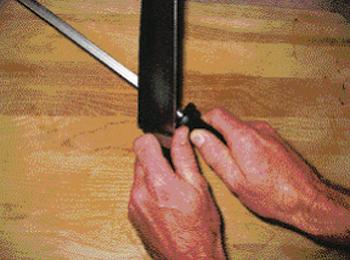Chefs are serious about their knives. In the kitchen, chefs share pots and pans, but knives — these sacred instruments are personal and belong to the chef alone. So connected is a chef to his knives that, on Bravo TV’s
Chefs are serious about their knives. In the kitchen, chefs share pots and pans, but knives — these sacred instruments are personal and belong to the chef alone. So connected is a chef to his knives that, on Bravo TV’s hit reality series “Top Chef,” when one of the contestants is eliminated, they don’t just boot that chef from the show, they kick off his knives as well saying, “Please pack your knives and go.”
If you want to get serious about cooking, you need your own set of good, quality knives. Nothing saps the joy from cooking faster than fumbling with a poorly designed, lightweight piece of junk. Good cooking begins with a good knife, an ergonomic handle sandwiched around a substantial, perfectly crafted blade.
Happily, excellent knife sets, complete with a wooden block to store them in, are now so affordable that it makes good sense to pick one up. You can get a lovely set of high-carbon stainless steel Henckels knives for well under $200, Global knives for a little more, or Wusthof knives, which can get pretty pricey.
Don’t have $200? Then start with a set of the two most important knives — a chef’s knife, the workhorse, and a paring knife for more delicate operations. You’re far better off with a quality duo than a whole battery of second-rate cutlery.
You’ll be spending a lot of time with your chef’s knife, so make sure to hold it in your hand before making a purchase. See how it feels, how it fits in your hand. Notice how much the cutting edge curves, as this can vary markedly between manufacturers and even between a single manufacturer’s different product lines. Make sure the blade is wide enough to allow plenty of room for your knuckles beneath the handle — that’s key.
I prefer knives with a bolster (a heavy, thickened section of the blade right next to the handle) because it gives the knife some mass and centers its balance. Of course, this also makes a knife weigh more, which you might not like. A knife is a very personal thing, so take the time to find a knife that feels good to you.
Your new knife will be extremely sharp, but will begin to dull after just a few uses — sooner if you use plastic cutting boards rather than wood. That’s because the cutting edge is so thin and delicate that it becomes wavy and begins to fold over itself. A sharpening steel (technically speaking, a honing steel, since it doesn’t remove any steel from the blade) straightens out the edge and makes the knife cut well again. Manufactures often include a sharpening steel with their knife sets because they know that a dull knife is difficult to use and, because of the additional pressure you needed to make a cut, can be dangerous. It’s good practice to hone your knives every time you cook.
Honing will keep your knives sharp for a while, maybe several weeks. But eventually, honing alone just won’t cut it. They’ll need sharpening. And, as with the knives, skimping on a sharpener is a bad idea. Cheap, ceramic disc-type sharpeners will just frustrate you. Sharpening stones are gentle on knives, but can be painstaking to use. The new foolproof electric models are ultra-convenient, but tend to be expensive. My favorite choice is a two-stage manual sharpener with diamond abrasion, which can be purchased for around $25 and works like a dream. Mine was available at Macy’s.
Once your knives are sharpened and honed, slip them back into their slots in a wooden block to protect their edges. Tossing them into the drawer can ding blades and then, when you reach in, cut your fingers. As for the dishwasher: Manufacturers don’t recommend it, but I know people who do, and their knives seem fine. I hand wash. It’s a personal thing.
What’s important is that you treat your knives with care. Hone them daily. Sharpen them monthly, and enjoy them. Now please unpack your knives and go cook.
• Luke Shanahan is co-author of “Deep Nutrition,” and is currently working on his next book, “Sexy Foods, Healthy Foods.” Shanahan lives in Kaua‘i.



